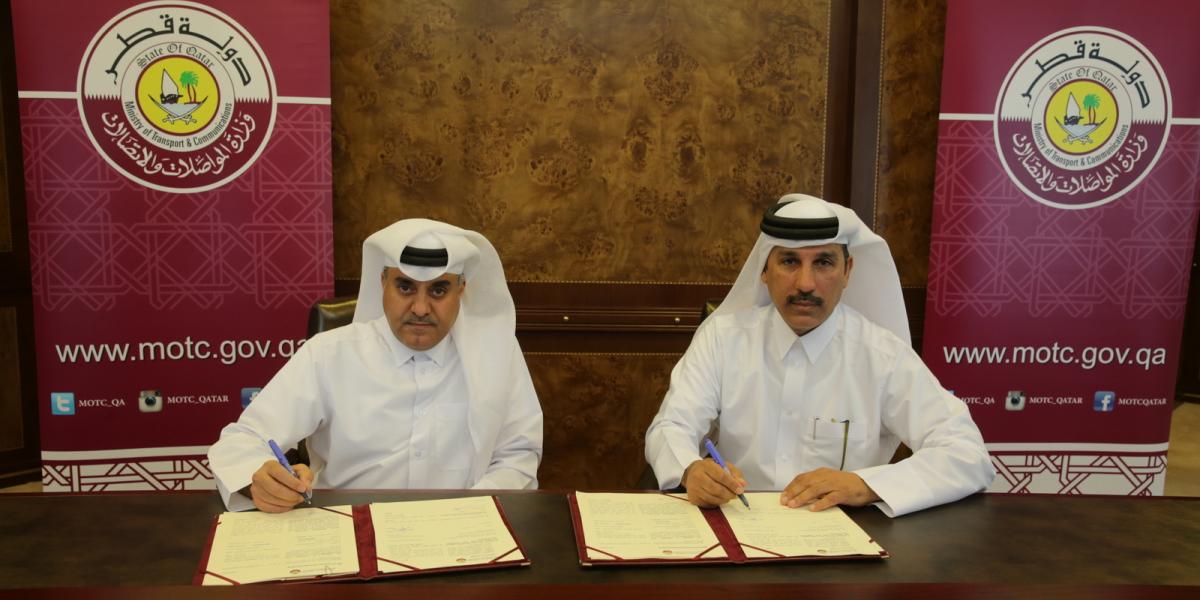Doha – Qatar
The Ministry of Transport and Communications (MoTC) has signed here four memoranda of understanding (MoU) in land transport field as part of its efforts to develop a modern transport sector for the State of Qatar. The agreements also reflect Ministry’s efforts to encourage private sector’s contribution to mobility projects.
The first MoU with Smart Transport to explore potential ventures was signed by Mr. Hassan Al Hail, the Minister’s Advisor, and Smart Transport’s Chairman Mr. Abdulaziz Bin Ali Al Attiyah.
The project would reflect the Ministry’s interest in developing transport related manufacturing in the country. The MoTC envisioned itself to provide a multi-modal transport system that is integrated, accessible and inclusive for all citizens in the State of Qatar.

In addition, this project invites public-private partnership, as it would help elevate the efficiency of facilities for local communities and support economic development. It is envisaged that these would assist in business development and contribute to achieving economic, social, human and environmental development goals of the Qatar National Vision 2030.
The second MoU with Union Global Projects to explore potential ventures was signed by Mr. Hassan Al-Hail, the Minister’s Advisor, and Union Global Project’s Chairman Sheikh Abdulrahman bin Jassim Ali Al Thani.

The agreement reflects Ministry’s interest in developing transport-related manufacturing industries in the country to contribute to diversifying and expanding the economic activities in Qatar.
The third MoU with Mawaqif Zakia to explore potential partnership to create an automated parking system in West Bay was signed by Assistant Undersecretary of Land Transport Mr. Rashid Taleb Al Nabet and Mawaqif Zakia’s General Manager Mr. Mohamed Hlep.

The project reflects the considerable attention the Ministry pays to providing an integrated transport system and solving parking problems in the country. It also promotes public-private partnerships, as it would help elevate the efficiency of facilities for local communities and support economic development. It is envisaged that these would assist in business development and contribute to achieving economic, social, human and environmental development goals of Qatar National Vision 2030.
Moreover, in a strategic move to take the Connected & Automated Vehicles program (CAV) in Qatar to the next level, the Ministry signed an MoU with the Qatar Mobility Innovations Center (QMIC), per which a consortium on CAV is announced. This is the first consortium to be created on CAV in Qatar and the region aiming to create the ecosystem needed for facilitating early deployment of CAV at national and regional scale.
The MoU was signed by Assistant Undersecretary of Land Transport Mr. Rashid Taleb Al Nabet and QMIC’s Executive Director and CEO Dr. Adnan Abu-Dayya.

This MoU officially declares the Ministry as a founding member of the consortium. Given its mandate and leading role in realizing advanced and seamless transport systems and road safety technologies in Qatar, the Ministry will play an important advisory role and aid in facilitating development and piloting activities in support of getting Qatar ready to deploy CAV systems and applications.
CAV refers to the concept, where as part of newly emerging cooperative intelligent transport systems, vehicles will be able to communicate with one each other and with the road network wirelessly (V2X) according to global standards.
This will enable the realization of next generation Road Safety Systems. It is considered as a key enabler for future autonomous and self-driving vehicles. Studies conducted by various transport authorities show that connected vehicles, if fully implemented, could mitigate up to 80% of road accidents. In the past, the focus has been on how to survive accidents; CAV aims to avoid them completely, as well as enhancing our daily driving experience, as a whole.
QMIC has been very active in the area of CAV since 2010, and back in 2014, it carried out the first field demo of an industry-compliant V2X system and applications in the Middle East and North Africa (MENA) region at the Qatar Science and Technology Park (QSTP). As the next step to facilitate potential full deployment of technology in Qatar, QMIC has committed plans to carry out a field pilot of V2X systems (Qatar V2X pilot) and applications in 2017/2018 in Qatar. This will allow QMIC and its partners to test CAV in real field scenarios as vehicles and roadside units will be used together with a few applications.
“Today’s MoU is a gateway for a strong partnership with QMIC. This is an exciting opportunity to adopt a new data-rich environment which will be the foundation for numerous new applications that will make our roads safer, less congested and more eco-friendly,” said Mr. Al Nabet.
He added that the Ministry “works on providing world-class transportation and communication systems that support Qatar’s economic and social growth and sustainable development.”
Dr. Adnan Abu-Dayya, the Executive Director and CEO of QMIC said: “Since 2011, we have outlined a long term strategy to become a leader in the area of intelligent mobility, in general, and in the CAV area, in particular. I am very glad to see us successfully moving from the R&D stage in CAV to the field piloting stage, which is a critical step towards getting Qatar ready for a potential large deployment before 2022. Our partnership with MoTC is a significant positive step for facilitating such deployment to the benefit of all stakeholders in Qatar. We look forward to welcoming other key stakeholders to this consortium, as collaboration and engagement are important keys for sustainable success. We also take this opportunity to thank the Qatar National Research Fund for supporting us in our CAV journey.”
Per the MoU, the Qatar CAV consortium stakeholders will be holding periodic meetings (most probably every 3 months), during which the progress of the Qatar CAV pilot will be reviewed and discussed. These meetings will be a good platform for the involved partners to provide their perspectives and suggestions that not only could help in the success of the CAV program, but also in making its outcomes the most relevant to the country’s requirements.

